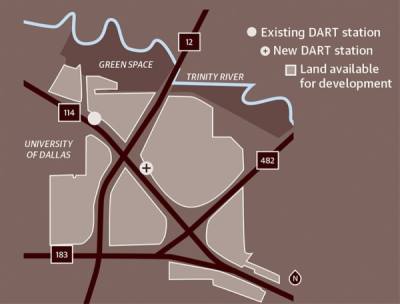The land, set near the geographic epicenter of the Dallas-Fort Worth area, covers the former Texas Stadium site and totals 1,000 acres.
Its location requires a strategic approach to development, according to city officials.
But before the city can begin soliciting projects from commercial and real estate developers, improving road infrastructure is first on the to-do list for the development, according to the mayor.
The Texas Department of Transportation will begin work early this year on a $420 million revamp of the site where SH 114, SH 183 and Loop 12 converge, dubbed the “diamond interchange.” This work will provide needed connector ramp upgrades while also improving traffic flow in anticipation of the tens of thousands of new employees and residents destined for the future mixed-use development, Irving officials said.
The site will include a mix of single- and multifamily residential; offices; green space; and a new Dallas Area Rapid Transit light rail station. The future construction is expected to boost the city’s tax base for decades to come.
Irving Mayor Rick Stopfer underscored the scale of the project at the annual state-of-the-city address Jan. 16.“We shouldn’t build an office building in there that’s less than 15 stories,” he said at the address. “We shouldn’t build an apartment complex that’s less than 10 stories because if we’re going to move this city forward, we’re going to need a tax base in the future. This whole development in this area will probably never be completed in my lifetime.”
Mixed-use development
Future development on the 1,000-acre site has the potential to address a compounding series of problems: Population increases are fueling demand for housing, while more drivers on roads contribute to worsening traffic conditions and air quality.“There’s not a lot of develop-able land available left,” Irving Assistant City Manager Philip Sanders said. “There’s this demand for ... office space that’s conveniently located [near] our airports and downtown Dallas, and I think [the project] is a solution for a lot of those types of issues.”
Several years ago, Irving planners created a comprehensive zoning ordinance to clear the way for future construction, Sanders said.
At full build-out, the site will include transit-oriented developments that will add office and retail space, entertainment venues, hotels and dense residential units, Irving Planning Director Steven Reed said.
“[The plan] does recommend very high density—at a minimum, 60 units per acre ... nearest the DART rail station, and an overall density of 40 units per acre throughout the rest of the development,” Reed said.
The master plan projects the construction of up to 9,201 residential units, while the whole development is projected to be able to sustain 20,500 new jobs, Reed said.
Irving Traffic and Transportation Director Dan Vedral said TxDOT’s initial road work at the diamond interchange will cause traffic disruption throughout its four-year timeline.
“This interchange is the confluence of three major freeway systems in Dallas,” Vedral said. “There’s a significant amount of traffic that goes through that, so therefore, there’s going to be a lot of disruption. But when it’s done, it certainly is going to be a showcase location [that] any sort of development would want to [be located] in.”
Drivers along SH 114 will have already noticed the construction of Irving’s Signature Bridge connecting the former Texas Stadium site to another soon-to-be developed tract of land, according David Springob, the city engineering manager overseeing the bridge construction. The Signature Bridge will feature lighting and canopy covers over the pedestrian walkways.
“It’s a critical connection because you want to hook the properties together,” Vedral said. “You certainly want to do it for the ease of people who are not only walking [and] cycling but driving. ... It provides direct ramps on 114, so there’s ... good vehicle access off of 114.”
The 500-foot-long bridge is expected to be completed by the end of 2020, according to the city.






